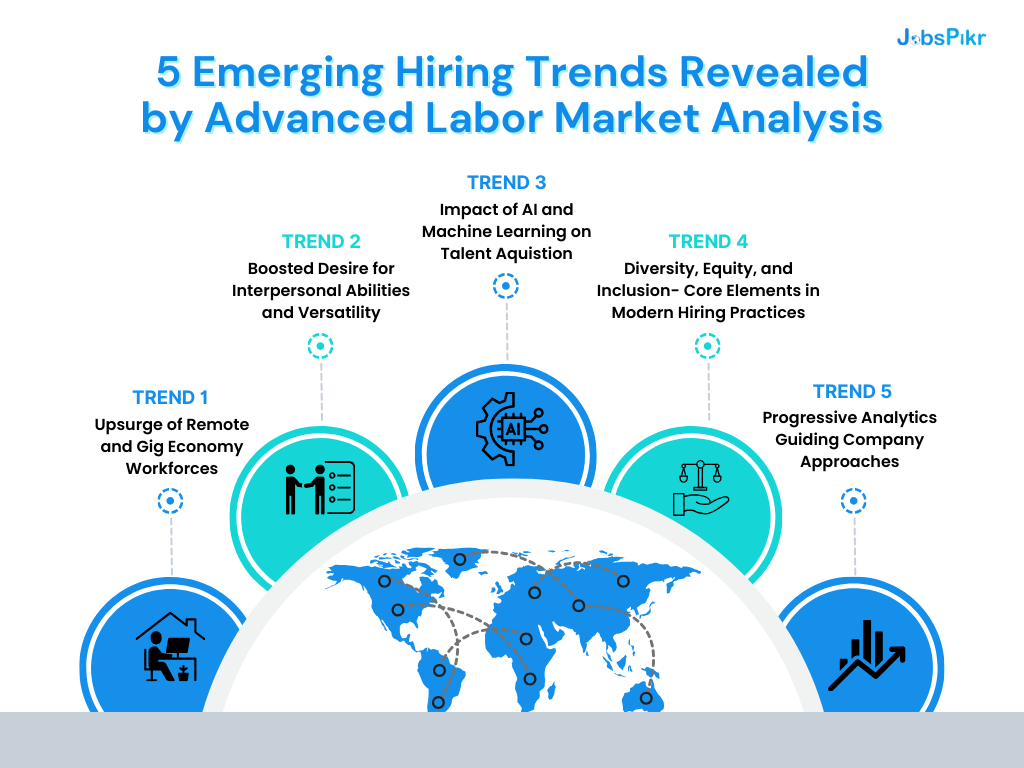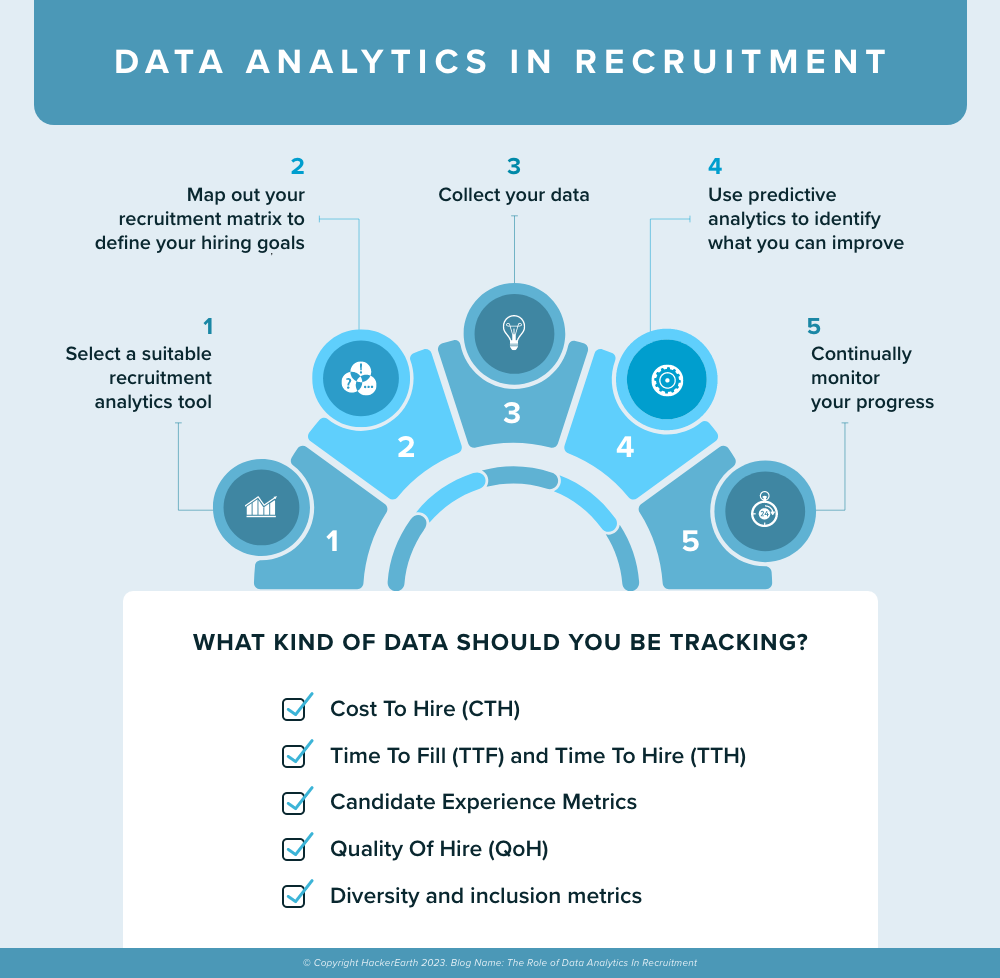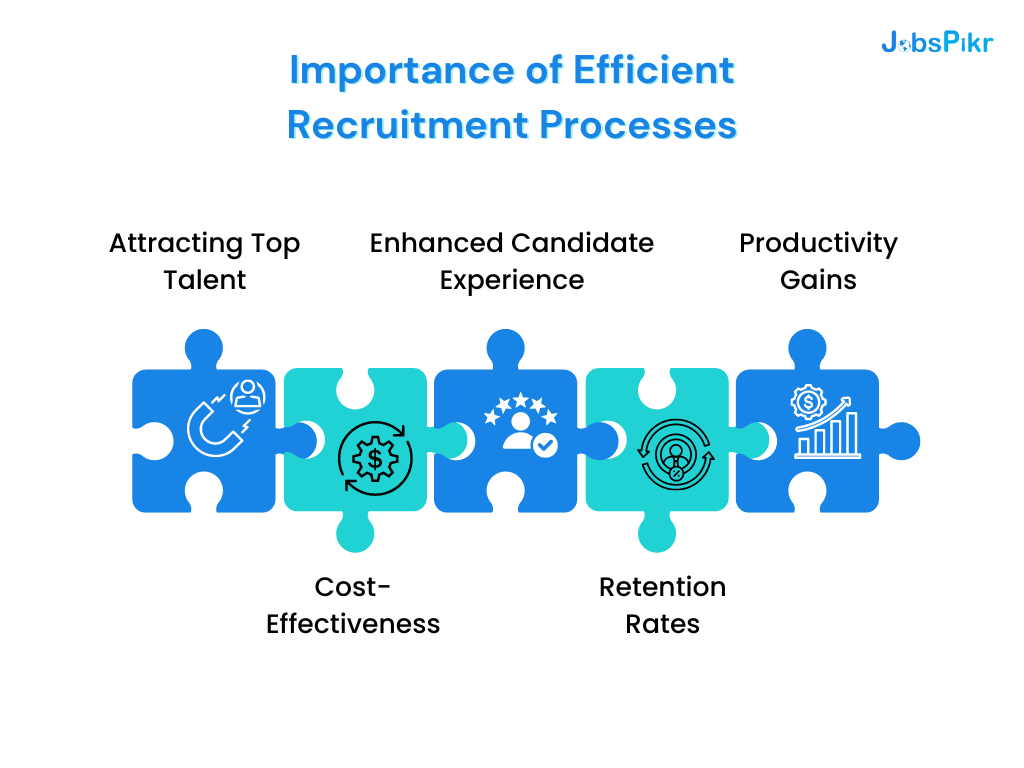What is Job Data Analytics?
Job data analytics involves the systematic computational analysis of employment data. It includes evaluating historical and current job market trends to make informed decisions. Key elements include:
- Data Collection: Gathering information from job postings, resumes, and employee performance records.
- Data Processing: Utilizing software to clean and organize raw data for analysis.
- Data Analysis: Applying statistical methods to interpret patterns and trends.
- Predictive Modeling: Using historical data to forecast future hiring needs and trends.

When implementing these features, organizations can expedite recruitment procedures, refine the evaluation of applicants, and minimize hiring-related expenditure and duration.
Benefits of Job Data Analytics in Recruitment
Utilizing job data analytics in recruitment offers numerous advantages:
- Enhanced decision-making: Provides insights for better hiring choices by utilizing relevant data to inform recruitment decisions.
- Cost efficiency: Reduces the time and resources spent on unsuitable candidates, leading to more cost-effective hiring processes.
- Improved candidate experience: Tailors the recruitment process to candidate needs, resulting in increased satisfaction and engagement during interviews.
- Better talent matching: Aligns candidates with the right roles using data-driven insights, increasing retention rates and productivity.
- Trend identification: Detects labor market trends early on, enabling organizations to adapt quickly and maintain competitive advantage.
- Bias reduction: Mitigates unconscious biases in recruitment, promoting diversity and inclusion within the workforce.
- Performance prediction: Forecasts candidate success through historical data analysis, ensuring long-term performance and growth.
- Recruitment marketing: Strengthens employer branding by understanding candidate preferences, and improving attraction and conversion rates.
Key Metrics to Track
Organizations should monitor several essential metrics to optimize their recruitment process. Key metrics include:

Image Source: Hacker Earth
- Time to Fill: This measures the average time taken to fill a vacancy from the initial job posting to the candidate’s acceptance. It helps organizations understand their efficiency in filling open positions and can inform staffing decisions.
- Quality of Hire: This evaluation tracks the performance of new hires over time, often measured through regular performance reviews or other metrics specific to the role. High-quality hires contribute positively to organizational goals and have lower turnover rates.
- Source of Hire: By identifying which recruitment channels produce the best candidates, this metric enables data-driven decision-making for future hiring efforts. Examples include employee referrals, career websites, social media platforms, or external recruiting agencies.
- Applicant Drop-off Rates: Monitoring drop-off rates during the application process reveals bottlenecks that may discourage potential applicants. Addressing these issues can improve the overall candidate experience and increase application completion rates.
- Cost per Hire: This calculation involves dividing the total recruitment costs (including advertising, agency fees, travel expenses, etc.) by the number of hires made within a given period. Lower cost per hire indicates more efficient use of resources in the talent acquisition process.
By examining these measurements, one obtains a tangible understanding to optimize hiring approaches.
Importance of Efficient Recruitment Processes
Successful organizations greatly benefit from effective and efficient recruitment procedures. They ensure:

- Attracting Top Talent: Swift processes help companies attract top talent by reducing the risk of losing qualified candidates to competitors due to long wait times or unclear communication during the hiring process.
- Cost-Effectiveness: Streamlining the hiring process can save costs by reducing expenses associated with prolonged vacancies (e.g., overtime pay) and extended search efforts (e.g., job advertising).
- Enhanced Candidate Experience: Organized recruitment procedures that prioritize clear communication, timely feedback, and efficient scheduling create a positive experience for candidates, which in turn reflects well on the company’s reputation and employer brand.
- Retention Rates: Thoroughly vetting candidates through comprehensive interviews, assessments, and reference checks helps identify those who are a better fit for the role and organization, resulting in higher retention rates and reduced employee turnover.
- Productivity Gains: Quickly filling open positions minimizes disruptions caused by staffing gaps, allowing teams to maintain their workflow and productivity levels without interruption.
An optimized recruitment procedure plays a critical role in preserving a company’s competitiveness and streamlining overall performance.
Implementing Job Data Analytics in Your Recruitment Process
To effectively integrate job data analytics, organizations should follow a step-by-step approach.
- Identify Objectives: Clearly define specific goals that you hope to achieve through data-driven hiring, such as decreasing time-to-hire by a certain percentage or enhancing overall candidate quality. Having clear objectives will help guide your efforts throughout the entire process.
- Data Collection: Compile relevant data from various sources, including applicant tracking systems (ATS), resume databases, social media profiles, and employee performance records. Make sure to gather both structured data (e.g., education level) and unstructured data (e.g., resumes).
- Data Analysis Tools: Utilize advanced analytics software and tools designed specifically for evaluating large datasets. These tools can help identify patterns, correlations, and trends within your data that would be difficult to detect manually.
- Model Creation: Construct predictive models using machine learning algorithms to evaluate candidate suitability and forecast future job performance. This may involve training models on historical hiring data and refining them over time as new information becomes available.
- Integration: Seamlessly integrate these analytical processes into your current human resources systems and workflows. Ensure compatibility between different platforms and applications to streamline operations and minimize disruptions.
- Training: Provide comprehensive training sessions for HR professionals and other stakeholders involved in the hiring process. Familiarizing them with data analytics tools and techniques is essential for successful implementation and long-term adoption.
- Continuous Improvement: Continuously monitor and reassess the effectiveness of your data-driven hiring strategies. Be prepared to adjust and fine-tune models based on user feedback, changing business requirements, and emerging best practices.
Conclusion
Analyzing job data plays a pivotal role in optimizing the recruitment process, offering insightful recommendations, and streamlining hiring approaches. Businesses utilizing this method can detect top-performing job platforms, recognize talent deficiencies, and capitalize on predictive analytics to anticipate future staffing demands. This data-driven approach helps in:
- Reducing time-to-hire and cost-to-hire
- Improving candidate quality and fit
- Enhancing the overall candidate experience
- Identifying trends to stay competitive in the talent market
When organizations incorporate job data analytics into their decision-making processes, they enable better, more effective recruitment results. Embracing these analytical tools promotes a more tactical, targeted, and edge-oriented approach to hiring.
With JobsPikr, you can access high-quality, structured job market data that fuels powerful analytics and drives informed decision-making. Our automated solution gathers millions of job listings daily, providing an extensive dataset tailored to your unique business needs.
Transform your recruitment efforts today – try JobsPikr now and unlock the potential of job data analytics!
Start your free trial today!



